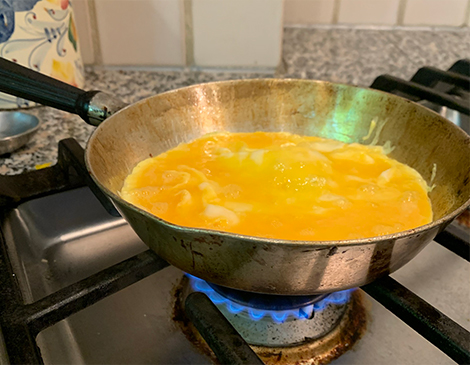The Oma pan is a tiny aluminum saucepan. It’s probably something you could buy at a thrift store for a dollar. But it’s mine, and it used to be my grandmother’s, and I think of her every time I use it to scramble a few eggs or melt butter for baking.
When we think of heirlooms, we tend to think of things with monetary value — jewelry, china, silver, maybe art or furniture. But when we think of inexpensive, decades-old household items, we tend to think of them as clutter.
I must admit, I’m kind of obsessed with decluttering. I tend to get easily overwhelmed by mess when I have too much stuff, so decluttering gives me a sense of clarity and order. Fewer things mean fewer things to clean and put away. And at this stage of my life, with five busy people in my household, managing all our stuff is especially important.
Back when my 94-year-old Oma died, I’d just gotten married, and I was finishing up law school several states away. When it was time to divide up Oma’s belongings, my four siblings and I were tasked with choosing items in turn until no one wanted anything anymore. Since I was away, my mom stepped in to pick for me, guessing as best she could what I might like or need for myself or my apartment.
When I next arrived at my parents’ house, I had a mishmash of stuff waiting for me. A pretty tablecloth cross-stitched by my grandmother. A dented kitchen funnel. A great-aunt’s partial silver set. A few pieces of midcentury glassware. A Gilhoolie tool (Google it — they’re amazing). My grandmother’s favorite earrings. A great-uncle’s watercolor painting. A decorative silver (pewter?) plate from Germany. A large circular mirror in a not-my-taste gold frame. Maybe there were other things, things I immediately rejected as clutter. But I only remember these things, the things I did take. You’d think that would make them important. And yet they sat, mostly unused for one reason or another.
I’m afraid to wear the earrings. They seem a bit delicate, and they should probably have a checkup with a jeweler. The great-aunt’s silver rarely comes out, and neither does the hand-stitched tablecloth, as it doesn’t really fit properly on any of my tables.
The gold mirror followed me through three moves, shuffling between attics and storage rooms, before it finally found a home above my youngest child’s dresser. I repainted the frame in a soft lilac that matches my daughter’s bedroom decor. She and Oma never met one another, but they share a birthday separated by 105 years, a connection that my daughter savors. When the mirror once again hung on a wall, it was transformed from dusty attic life to thoughtful everyday use, and in that move, it finally transcended its intermediate years as clutter. And therein was the magic: It had become useful again. Now it has a new life, a new story interweaving with the old.
The designer William Morris famously said, “Have nothing in your houses that you do not know to be useful or believe to be beautiful.” It’s as good a test for screening out clutter as any. All sentimental items are beautiful, I would argue, if they give us fond memories of loved ones. But what good are they if we never take them out, see them, use them? We’re neither using them nor enjoying their beauty.
That’s why I have a special fondness for everyday heirlooms. Because they’re not precious, we can feel free to use them all the time. Through these prosaic items, we spend our ordinary days in communion with the ordinary days that came before: ordinary childhood days when I’d wake up on the nubby living room couch after a sleepover at Oma and Opa’s apartment. The smell of French toast made from Oma’s homemade raisin bread coming from the kitchen, cooked on the gas stove that she lit with the boxed matches that always sat on the counter. There was a lot of cooking at her place, and while I don’t remember the Oma pan specifically — I tended to let her wait on me — using her cookware feels like a tangible connection to who she was, what she did for us, how we spent our time. Decades apart, our hands on the same tools, doing daily work — that’s both useful and beautiful, Mr. Morris.
I’ve always been fascinated with the everyday — the way people lived at home in other eras, seeing the home of a friend who’s moved (so I can picture them there when we talk), and even what my friends put in their grocery carts. I want to see people where they are when they are most themselves, and the material things of everyday life are a part of that.
It’s time I decluttered some neglected heirlooms — not by getting rid of them. No, I’m going to make them useful, which will save them from a life (a death?) in dusty storage. The earrings are going to the jeweler so I can wear them for the first time ever. My other grandma’s china will be coming out more often. The pretty glassware will go into more regular rotation.
Sure, there are risks. I may break these heirlooms or wear them out or even lose them. But, this much is certain — I won’t turn them into clutter.




